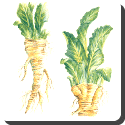 Horseradish — Horseradish (Armoracia rusticana, syn. Cochlearia armoracia) is a perennial plant of the Brassicaceae family, which includes mustard, wasabi, and cabbages. The plant is probably native to southeastern Europe and western Asia, but is popular around the world today. It grows up to 1.5 metres (five feet) tall and is mainly cultivated for its large white, tapered root.
Horseradish — Horseradish (Armoracia rusticana, syn. Cochlearia armoracia) is a perennial plant of the Brassicaceae family, which includes mustard, wasabi, and cabbages. The plant is probably native to southeastern Europe and western Asia, but is popular around the world today. It grows up to 1.5 metres (five feet) tall and is mainly cultivated for its large white, tapered root.
The horseradish root itself has hardly any aroma. When cut or grated, however, enzymes from the damaged plant cells break down sinigrin (a glucosinolate) to produce allyl isothiocyanate (mustard oil), which irritates the sinuses and eyes. Once grated, if not used immediately or mixed in vinegar, the root darkens and loses its pungency and becomes unpleasantly bitter when exposed to air and heat.
Horseradish is perennial in hardiness zones 5 – 9 and can be grown as an annual in other zones, though not as successfully as in zones with both a long growing season and winter temperatures cold enough to ensure plant dormancy. After the first frost in the autumn kills the leaves, the root is dug and divided. The main root is harvested and one or more large offshoots of the main root are replanted to produce next year’s crop. Horseradish left undisturbed in the garden spreads via underground shoots and can become invasive. Older roots left in the ground become woody, after which they are no longer culinarily useful, although older plants can be dug and redivided to start new plants.
Cooks use the terms ‘horseradish’ or ‘prepared horseradish’ to refer to the grated root of the horseradish plant mixed with vinegar. Prepared horseradish is white to creamy-beige in color. It will keep for months refrigerated but eventually will start to darken, indicating it is losing flavor and should be replaced. The leaves of the plant, which while edible aren’t commonly eaten, are referred to as ‘horseradish greens.’ Although technically a vegetable, horseradish is generally treated as a condiment or ingredient.
Horseradish contains potassium, calcium, magnesium and phosphorus, as well as volatile oils, such as mustard oil, which is an antibiotic. Fresh, the plant contains average 79.31 mg of vitamin C per 100 g of raw horseradish.
 Kids Portal For Parents India Kids Network
Kids Portal For Parents India Kids Network






